Accessory Review
Checkpoint Flyer (and Accessories)
Checkpoint Flyer

I never thought of myself as a bag hound—until recently, when I knew my new Tom Bihn Checkpoint Flyer (with accessories) was on the way, and the excitement rose in my chest every time I turned the corner to my house for the days leading up to the delivery. But I don’t mind the label; along with my possibly-overactive interest in productivity, I have a special fondness for organization and tools for creating it.

The Checkpoint Flyer, from the front.
Tom Bihn’s impressive selection of such tools makes my mouth water. And the package that landed at the Eubanks house a while back—packed full of Bihn gear—has satisfied my bag-houndedness for now.
The Checkpoint Flyer is specially designed to accommodate frequent travelers, particularly those who fly (thus the name). In the wake of the 9/11 terrorist attacks, most of us have experienced the tightening of security in certain ways when we prepare to board an airplane. Perhaps, like me, you have been exasperated with the hassle of removing your laptop from its bag and separating it from the rest of the stuff you’re sending through the X-ray machine.

Open as it would be for X-rays—notice the laptop sleeve (far right) that separates the computer from the rest of the bag.
Enter the Checkpoint Flyer. It turns out that the Transportation Security Administration (TSA) allows for laptops to remain in bags that are designed in such a way that still allow the computer to be X-rayed in isolation from the rest of the bag’s contents. This capability sets the Checkpoint Flyer apart from most laptop bags.
There are broad reports that TSA officers do not give any trouble for these bags, though I confess I have not yet had the opportunity to put mine to the test. I will say this: if it is half as easy as it seems like it could be, my stress levels during travel will go way down.
The Checkpoint Flyer is, in true Tom Bihn fashion, a well-designed bag. It is attractive, made of a nice, heavy 1050 denier ballistic nylon with hefty zippers and appealing color schemes. More than that, it packs a lot of function into the pleasant form.
The molded laptop case portion of the Flyer is very sturdy, offering more protection than a typical sleeve or insert. It has a heavy zipper, like the rest of the bag, and is molded to fit my 13″ MacBook perfectly. (When you order your bag, you specify what size laptop case you want with it; you may also order replacements or additional sizes separately from Tom Bihn.) It attaches to the main carcass of the bag using small, sturdy clips of a design I’ve never seen before; what is more, it detaches with those clips as well, giving an option of using the molded case as a streamlined on-the-go case. A single handle mounted on the top makes this even easier.

Here is the “small, sturdy clip” that attaches the sleeve to the rest of the bag. The metal latch is spring-loaded and opens easily.
When the molded laptop case is attached to the bag carcass, it folds up under a large flap, which buckles over it to hold your laptop securely. The flap houses a couple of spacious pockets, and a slit in the flap allows the single handle on the molded case to become one of the two handles that you use to carry the bag. It’s a clever design, combining security and protection for your computer with useful function, and smartly avoiding redundant handles while allowing for maximum flexibility.
The rest of the carcass is a large briefcase with more pockets inside and out. In fact, there are so many pockets that I haven’t decided how or when to use them all, even though I’ve used my Checkpoint Flyer daily for several weeks now. The main compartment of the briefcase is roomy enough for several books in addition to my Horizontal Freudian Slip (more on it in a moment). Since my work requires a lot of reading, it’s great to be able to pack a single bag to take home from my office on most days. The briefcase is also well padded, and more cleverness is found on the back: a magazine-sized pocket and a map- or boarding-pass sized pocket, with a zip-open slot to allow the Checkpoint Flyer to slip over your rolling luggage handle.

The back of the Checkpoint Flyer: you can see the magazine pocket that also zips open to fit over luggage handles.
I like the Checkpoint Flyer a lot, and find it very comfortable for regular daily use. With other bags I’ve used, I tend to pack based on what I’ll be doing: I have a smaller messenger bag that used to be my daily bag, and a nice laptop-carrying backpack for traveling. With the Flyer, though, I’ll probably stick with it as my regular bag and travel bag. It has more than enough pockets for the accessories I use regularly, and space to stash extra accessories as needed for travel. And as I said before, there is enough room for books and a few files as well.
My one complaint about the Checkpoint Flyer is something that, given the special TSA-compliant design, is unavoidable: since the molded laptop case folds out for X-rays, it also folds out at other times. Basically, this part of the bag has a tendency to “flop” around unless you buckle it back in. This means that, when I get to my office, I have to buckle it closed without my MacBook in it in order to use the bag during the day without the flop factor. Then I must unbuckle it again to re-load the computer into it at the end of the day. A niggly complaint, I know—but I have grown used to bags that I can get into very easily throughout the day without a lot of open-and-close to pack up. On my messenger bag, for example, the laptop compartment is closed by a velcro flap, and this is substantially less trouble to get into than the buckles of the Flyer.
This is a minor hassle—and one I’ll surely get over after a few more weeks.
Let me make a mention of a few of the accessories that I got with my Tom Bihn bag: the Horizontal Freudian Slip and the Absolute Strap.
Horizontal Freudian Slip

The Freudian Slip is Tom Bihn’s answer to the problem of loose files and other paperwork in a briefcase. A file folder stuffed into a softside briefcase, along with a few books or other bulkier items, is bound to get crimped or bent. Loose papers are even worse, usually ending up crumpled and even unusable—certainly less presentable.
A lot of bags offer as a solution a designated file or paper section. (I should say, a lot of bags used to offer that solution; I haven’t seen this on a laptop bag in a while, but then it has been a while since I abandoned my Targus laptop briefcase for other styles of bags.) But the problem here is space designated for a purpose that may not always be necessary, thereby rendering it useless space at times. Who wants to haul around a bag that has an empty compartment for some or much of the time?

The Freudian Slip from the back—accessory pocket side.
Tom Bihn designed the Freudian Slip to solve this problem. It is a semi-rigid insert, with pockets for files and paperwork on one side and smaller slots, pockets, and slips on the other. Think of it as the boardroom pull: when you sit down at a meeting, pull out your Freudian Slip and you’ll find all that you need there—files, papers, pens, other tools.
Like all Bihn designs, the Freudian Slip a handsome design that is also surprisingly well thought-out. It’s soft enough to work well in a soft bag: it flexes to fit around other things in your bag, so it won’t suck up too much precious space. Most of the time, it fits up against the side, and I hardly notice that it is there (until I need it!). The file pockets on the horizontal version are wide enough to house legal-sized as well as letter-sized files (a Vertical Freudian Slip is available as well, which doesn’t hold legal-sized files but has more pockets for letter-sized files). And the pockets for pens, notepads, Post-It flags, and other tools are great—there’s plenty of room for anything I carry, and none of it is loose in my bag. I love my Freudian Slip.

The Freudian Slip from the front—file folder side.
Absolute Strap

The Absolute Strap is so called because of its claim to “absolute comfort.” I’ll grant that it is a very comfortable strap. Nylon Webbing makes up the part that connects to the bag, but the portion that sits on your shoulder is made of a heavy neoprene (think scuba wetsuits) that has a good amount of give and stretch to it, cushioning the weight and preventing the normal swing and movement of the bag from digging into your shoulder.
I’ve had neoprene straps like this before (especially for cameras), and they have always allowed too much bounce—but the Tom Bihn strap has a hem sewn into the neoprene that mitigates the bounce, while keeping the give and cushion. Well done.
The straps on the Absolute Strap work well, but the look and feel of the Web strap doesn’t quite fit, either with the rest of the Absolute or with the Checkpoint Flyer. The weave on the web is coarse, and I have seen straps with smoother, more elegant webbing. Function is more important than form here, but Tom Bihn is usually so attentive to both function and form that I give a few small marks against the Absolute Strap for that.
• • •
Overall, I can’t recommend Tom Bihn bags and accessories highly enough. I’ve never known someone who owns a Bihn bag that is unhappy or dissatisfied with it, and I say the same about the Checkpoint Flyer and the accessories I got with it. In fact, I like the Bihn Checkpoint Flyer as much as any bag I own. The price isn’t modest, and there are good bags available for less money—but for the quality of the Bihn bags, I consider the price reasonable.
Reader Comments (0)
Add A Comment